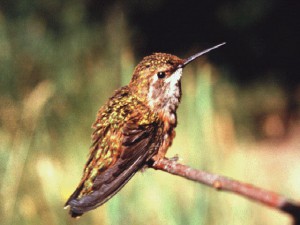 The American anthropologist Dr. George M. Foster, in Funk & Wagnalls Standard Dictionary of Folklore Mythology and Legend, (1949) Maria Leach (ed.) New York, 1972, p.510 writes
The American anthropologist Dr. George M. Foster, in Funk & Wagnalls Standard Dictionary of Folklore Mythology and Legend, (1949) Maria Leach (ed.) New York, 1972, p.510 writes
“HUMMINGBIRD: A minor character in American Indian folktale and mythology. The northern Paiute Indians [U.S. Great Basin area] say that Hummingbird once filled his pants full of seeds and started on a journey to see what was beyond the sun. He ate only one seed a day, but had to turn back because his food gave out. He didn’t see anything. In eastern Brazil, Hummingbird is the character who hoarded water so that the people had none at all until the Caingang and Botocudo Indians released it.
Since pre-Conquest times the hummingbird has been considered by many Middle American [Central America] peoples to have supernatural powers. Today it is esteemed by many as a love charm. A dead hummingbird may be worn around the neck in a little bag, to give the wearer the power to attract members of the opposite sex, or it may be dried and a little powder dropped into the drink of the person whose love is desired.”
Philip Drucker, on page 451 of The Northern and Central Nootkan Tribes [on the west coast of Vancouver Island] Smithsonian Institution Bureau of American Ethnology Bulletin 144, U.S. Government Printing Office, Washington, 1951 wrote:
“Miscellaneous toys and amusements of children included…trapping hummingbirds by smearing slug slime on twigs [that acted like a glue] in the vicinity of flowering plants. The unfortunate birds so captured were fastened to a string, threaded through their nostrils, so the children could play with them, making them fly round and round. Other small birds, when they could be caught alive, were similarly maltreated, the string being sewn either through their nostrils or through from one eye to the other.”
Pages 472-549 of The Report of the 70th Meeting of the British Association for the Advancement of Science (1900) include “Notes on the Skqomic of British Columbia” by Charles Hill-Tout. The section mentions a legend about Hummingbird, Bumblebee, and Wren who fly round salmonberries that were produced by magic in order to ripen them. Today the Skqomic are usually referred to as the Squamish. They live in an area to the north and north-west of Vancouver on the coastal mainland of B.C.
A number of First Nations artists of the Pacific Northwest have used hummingbirds as the subject of their artwork. Not least of them is Art Vickers.
There is a common belief that hummingbirds hitch a ride in amongst the feathers of much larger birds, such as Canada Geese, during their migrations. A brief account in the Argentinian legend One More Point than the Devil shows that the same belief, or a related belief, also exists in Argentina. The tale tells the adventures of the three sons of a poor farmer. Tired of being poor the boys, starting with the eldest, go forth to seek their fortune. One by one they enter service with the Devil only to be dismissed for being unable to accomplish the tasks set them. Eventually Sulca, the youngest son, succeeds but expects to have a battle of wits with the Devil soon in the future. One of the battles that transpires entails shapeshifting (Thompson, Motif : D615.2. Motif : D615.2.) and, when the following account opens, Sulca is in the shape of a horse…
“The horse jumped into the water and changed himself into a catfish. The Devil jumped after him and changed himself into a gilthead. The gilthead set to work to chase the fish, and was about to seize it when the catfish, having reached the other shore, turned into a deer which began to run over the mountain. The gilthead came out of the lake and turned into a hound which started running at full speed after the deer, but when the hound was on the point of catching it and tearing it to pieces, the deer changed into a dove. Then the hound became a hawk which soared up into the sky after its prey. When the dove tired, it turned into a hummingbird and took refuge in the feathers of an eagle flying by. The hawk then turned into a condor, and the condor, lifting himself up to the clouds, followed the eagle until he overtook him. The two began to fight, and as they passed over a very high tower, the hummingbird slipped away from the eagle’s feathers and flew into a window. When the condor tried to squeeze after the hummingbird, Suca, returning suddenly to his normal shape, shouted, “The Cross, Devil!” and the enormous condor vanished like smoke in the wind.”
……which is not the end of the tale, the whole of which can be found in Folk Songs and Stories of the Americas published by the Pan American Union, Washington, 1937.
Thanks to our member David Querido for pointing this one out to us.
Readers who want to explore further legends of hummingbirds might want to refer to: Xingu; The Indians, Their Myths, [of Brazil] by Orlando Villas Boas and Claudio Villas Boas, published by Farrar, Straus and Giroux, New York, 1973. Hummingbirds are specifically part of the legend: Kanarate and Karanavare; Jealousy and Fratricide, on pages 213-225.
As an afterword, the late Phil Cave, who was a logger living in Salmon Arm, gave us this small gem that we subsequently published in B.C.FOLKLORE 1:4, “So broke you couldn’t buy a pair of leggings for a hummingbird.”
